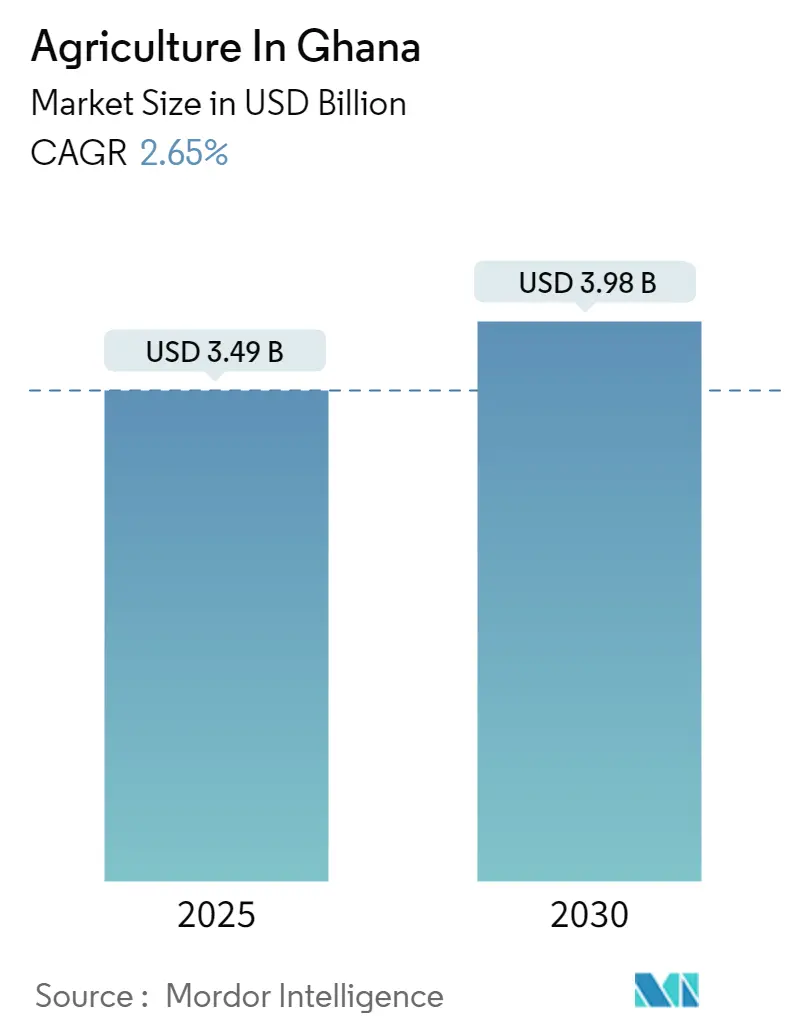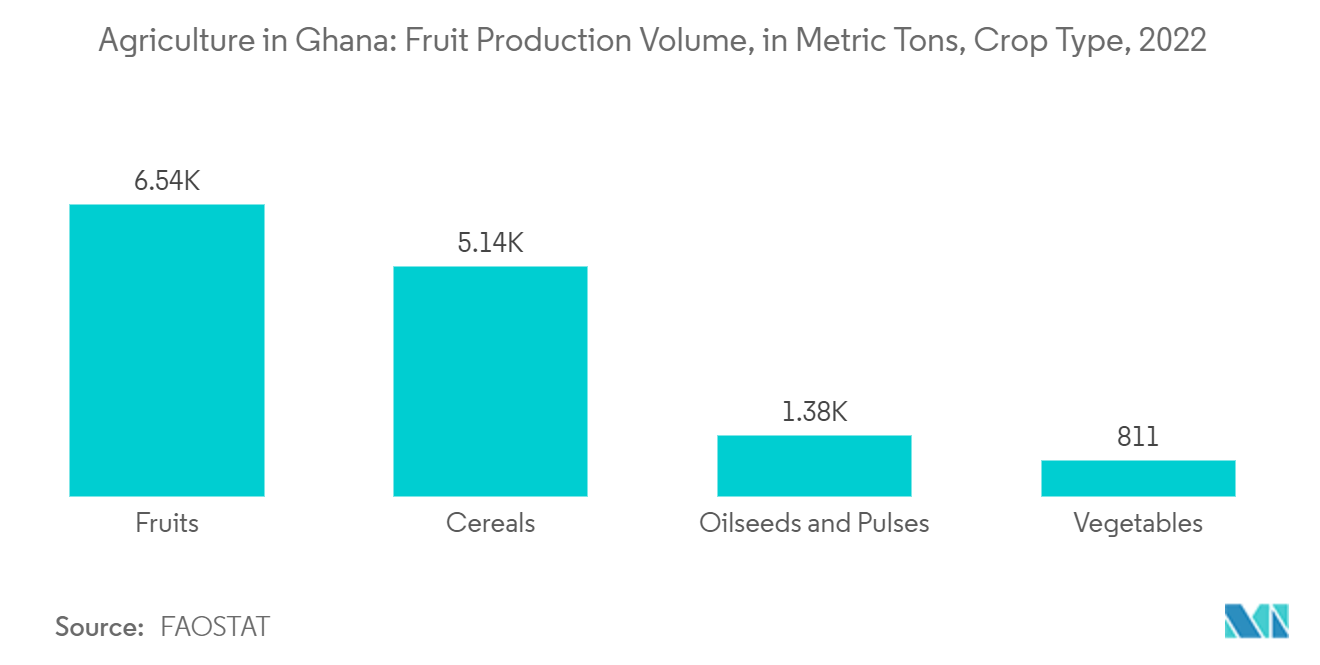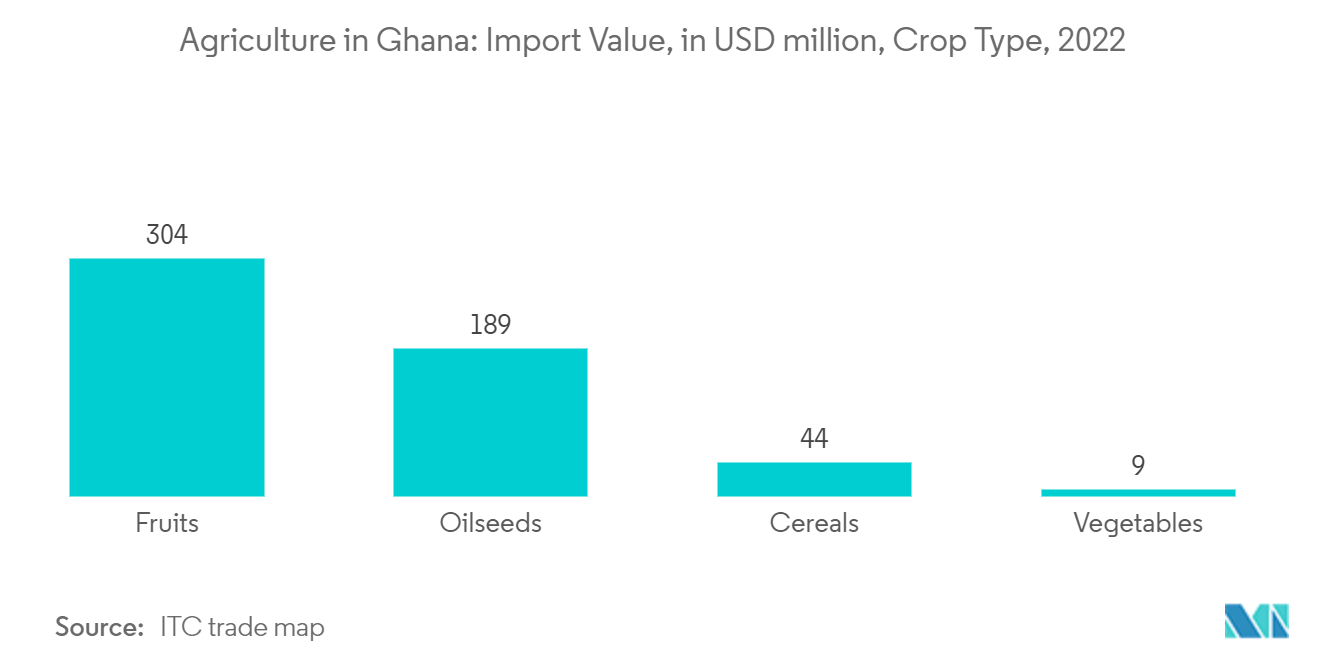Agriculture In Ghana Market Analysis
The Agriculture In Ghana Market size is estimated at USD 3.49 billion in 2025, and is expected to reach USD 3.98 billion by 2030, at a CAGR of 2.65% during the forecast period (2025-2030).
Ghana's agricultural market, which includes crop production, livestock farming, fisheries, and agro-processing, plays a crucial role in the nation's economy. Agriculture not only ensures food security and provides employment but also significantly impacts trade and exports. It's a key driver of Ghana's foreign exchange revenues and overall economic vitality. The sector's increasing contribution to GDP highlights its rising significance. World Bank data underscores this trend showcasing that the agricultural sector's share of Ghana's GDP increased from 19.5% in 2021 to 21.1% in 2022. Modern innovations, such as digital technologies, precision farming, and smart irrigation, promise to enhance productivity and broaden market access. In 2023, Complete Farmer, a digital platform connecting African farmers, including those in Ghana, to global markets, secured a USD 10 million funding boost for its expansion.
Ghana is striving for self-sufficiency, focusing on enhancing agricultural productivity, ensuring better financial access, and promoting improved nutrition. The country is committed to producing a diverse range of nutrient-rich foods and collaborates with commercial agricultural enterprises to elevate operations to meet both national and international standards. Special emphasis is placed on northern districts, where poverty is prevalent and food security remains a challenge. To underscore these initiatives, the United States Agency for International Development (USAID) and the UN World Food Programme (WFP) launched a USD 7 million initiative called 'Farmer Support Activity' in 2023. This program supported 17,000 vulnerable smallholder farmers in the Upper East, Upper West, Northeast, and Northern Regions during the lean season. The initiative, in collaboration with the Ministry of Food and Agriculture and other partners, provides cash transfers and agricultural training. The primary objectives are to enhance food security, improve livelihoods, and foster sustainable agricultural development in Ghana.
Agriculture In Ghana Market Trends
Growing Fruits Production Supports the Market
Ghana's agricultural sector heavily relies on fruit production, which significantly enhances food security and export income. The country's tropical climate supports the cultivation of a wide variety of fruits, making Ghana a significant player in both regional and international fruit markets. The nation produces several fruits, including pineapple, mango, banana, citrus, and papaya. FAOSTAT reports that in 2022, Ghana's fruit production reached 6,539 thousand metric tons, surpassing other crops like cereals at 5,136 thousand metric tons, oilseeds and pulses at 1,381 thousand metric tons, and vegetables at 811 thousand metric tons. This increase is due to the expansion of the area dedicated to fruit cultivation, which grew from 485 thousand hectares in 2021 to 492 thousand hectares in 2022. The primary fruit-growing regions in Ghana are Greater Accra, Central, Eastern, and Volta.
The growing demand for fruit juices, dried fruits, and canned products has spurred growth in Ghana's fruit processing industry. Companies in this sector are concentrating on adding value to crops such as pineapples, mangoes, and papayas. In 2024, the U.S. Agency for International Development (USAID) allocated USD 440 thousand to enhance dried fruit production in Ghana. This funding aims to improve the processing capabilities of Pure and Just Limited, a Ghanaian company that converts fresh fruits like mango, papaya, pineapple, and banana into dried products using advanced agro-processing techniques. Consequently, the combination of high production, expanding cultivation areas, and increased demand from agro-processing industries drives market growth.
Cereal Imports dominate the Market
Cereal imports are crucial to Ghana's agricultural and food security framework. Despite being a significant agricultural player in West Africa, Ghana's domestic cereal production often fails to meet the rising demand, especially in urban areas. The increase in urbanization and changing dietary preferences have significantly boosted the demand for foods, including rice and wheat products. For instance, Ghana's urbanization rate grew from 58.6% in 2022 to 59.2% in 2023. Additionally, population growth continues to escalate the need for more food, further increasing the demand for cereals that local production alone cannot satisfy. Consequently, the country imports substantial quantities of cereals, such as rice, wheat, and maize, to address this shortfall.
According to the ITC trade map, cereal imports amounted to USD 304 million, oilseeds to USD 189 million, fruits to USD 44 million, and vegetables to USD 9 million in 2023. These imports primarily come from Vietnam, China, Thailand, and India. Vietnam holds the largest share at 77.6%, followed by 4.9%, 4.5%, and 4.3%, respectively. Additionally, rice, wheat, and maize constitute the major share of cereal imports in the country.
Moreover, climate change has disrupted rainfall patterns, temperatures, and extreme weather events (such as floods and droughts), leading to inconsistent cereal yields, particularly for maize and rice. Consequently, there are times when domestic production is insufficient, making imports necessary. Furthermore, the rising cost of inputs for cereal production in the country exacerbates the situation. According to the Ministry of Food and Agriculture Ghana, the price of hybrid maize seed increased from USD 0.5 in 2021 to USD 0.6 in 2022. These escalating input costs discourage farmers from producing these crops, thereby increasing the need for imports to meet local demand. Therefore, the growing local demand for cereals, coupled with production disparities, is driving market growth during the forecast period.
Agriculture In Ghana Market News
- June 2024: Ghana has introduced a new initiative to promote environmentally friendly practices in its agricultural sector. This initiative, funded by the Swiss State Secretariat for Economic Affairs (SECO), involves collaboration with the United Nations Development Programme (UNDP), the Forestry Commission, and the Ghana Cocoa Board (COCOBOD).
- May 2024: The Ghanian Ministry of Food and Agriculture (MoFA), in collaboration with the South Korean Ministry of Agriculture, Food, and Rural Affairs (MAFRA), has designated 100 hectares of land in Dawhenya, Ghana, for the development of a rice seed cultivation complex.
- March 2024: The National Service Scheme (NSS) has forged a strategic alliance with the World Food Programme (WFP) to bolster Ghana's agricultural landscape. This collaboration seeks to harness the latent potential within Ghana's agricultural sector, thereby advancing the agriculture market.
Agriculture In Ghana Industry Segmentation
Agriculture is the practice of farming, including the cultivation of the soil for the growing of crops and the rearing of animals to provide food, wool, and other products. Agriculture in Ghana includes the production of various crops, such as yams, grains, cocoa, oil palms, kola nuts, and timber, which form the agricultural base of Ghana's economy. The report defines agricultural products in terms of the end-users. The Ghana agriculture market is segmented by crop type into Cereals, Oilseeds and Pulses, Fruits, and Vegetables. The report provides production analysis (volume), consumption analysis (value and volume), import analysis (value and volume), export analysis (value and volume), and price trend analysis. The report offers market size in value (USD) and volume (Metric Tons) for all the above segments.
| Crop Type (Production Analysis by Volume, Consumption Analysis by Volume and Value, Import Market Analysis by Volume and Value, Export Market Analysis by Volume and Value and Price Trend Analysis) | Food Crops / Cereals |
| Oilseeds and Pulses | |
| Fruits | |
| Vegetables |
Agriculture In Ghana Market Research FAQs
How big is the Agriculture In Ghana Market?
The Agriculture In Ghana Market size is expected to reach USD 3.49 billion in 2025 and grow at a CAGR of 2.65% to reach USD 3.98 billion by 2030.
What is the current Agriculture In Ghana Market size?
In 2025, the Agriculture In Ghana Market size is expected to reach USD 3.49 billion.
What years does this Agriculture In Ghana Market cover, and what was the market size in 2024?
In 2024, the Agriculture In Ghana Market size was estimated at USD 3.40 billion. The report covers the Agriculture In Ghana Market historical market size for years: 2019, 2020, 2021, 2022, 2023 and 2024. The report also forecasts the Agriculture In Ghana Market size for years: 2025, 2026, 2027, 2028, 2029 and 2030.
Our Best Selling Reports
Agriculture In Ghana Industry Report
The global agricultural products market in Ghana is a cornerstone of the national economy, contributing significantly to GDP and employment through the cultivation of key agricultural products. The market report highlights the production analysis, consumption analysis, and import and export analysis, providing a comprehensive market overview. Government policies have bolstered the sector, focusing on stabilizing output and promoting sustainable growth with staples geared towards an expanding middle class.
Despite challenges like shrinking arable land and ecological pressures from intensive farming, ongoing initiatives are in place to adopt modern farming technologies and enhance productivity. The market structure and industry statistics reveal that complementary strategies promote environmental protection and resource efficiency. With persistent support from mechanisms like fertilizer subsidies and eased lending conditions, the sector is set for advancements, maintaining its crucial role in the economy and as a primary livelihood source.
The industry analysis covers various crop types, including cereals, fruits, vegetables, and oilseeds, providing detailed insights into the market segmentation. The market forecast and industry outlook suggest a positive growth rate, driven by continuous improvements in farming practices and government support. The industry size and market value are expected to increase, reflecting the sector's resilience and adaptability.
Industry reports and market research indicate that Ghana's agriculture sector is poised for significant growth, with market leaders playing a crucial role in driving innovation and sustainability. The report pdf offers a detailed examination of price trends and supply chain dynamics, essential for understanding market trends and predictions.
Research companies and industry research highlight the importance of market data and industry information in shaping strategic decisions. The market review and industry trends underscore the sector's potential for growth, supported by robust industry sales and market growth. The market outlook remains optimistic, with industry forecasts predicting continued expansion and development.
For more detailed Ghana agriculture statistics and insights into key agricultural outputs, industry reports are available for further exploration. The report example provides a comprehensive analysis of the sector, offering valuable information for stakeholders and policymakers. The report pdf download is available for those seeking an in-depth understanding of the market dynamics and future prospects of Ghana's agriculture sector.





